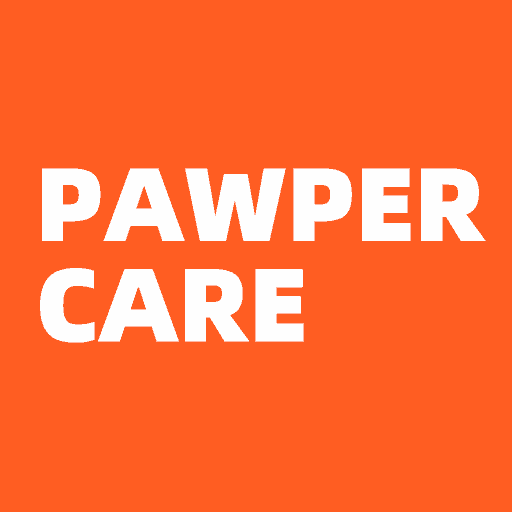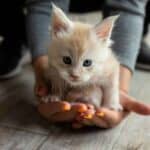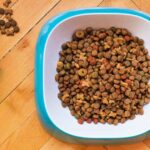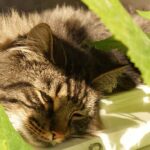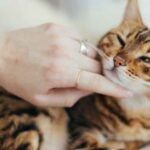If you have both a cat and a dog in the same house, there is one problem you cannot avoid: Your cat may occasionally eat your dog’s food. These two types of pet food are formulated very differently to meet the specific nutritional needs of each species. So, the question arises: Can cats eat dog food?
Many cat owners may be curious if dog food could be an edible substitute for cat food in a pinch.
However, what’s healthy for canine digestion and nutrition differs greatly from feline needs. Feeding the wrong diet can have consequences.
Dog food and cat food differ significantly in their ingredients, texture, and formulation. Both are optimized for the respective species’ diet and tastes. Dogs have omnivorous tendencies, whereas cats are obligate carnivores. This results in specialized nutritional profiles. Let’s analyze the key differences in more detail.
How Cat and Dog Foods Differ in Taste
A major barrier to cats eating dog food is palatability. Cats have a much stronger sense of taste than dogs. They require appealing flavors and aromas to feel motivated to eat food.
Dog foods often contain proportionally more plant material and grains than cat food. The textures and shapes may also differ, catering to a dog’s less finicky preferences. Many cats will reject or eat around crunchy kibble designed for a dog’s dental needs.
Cat foods will use more animal proteins and fats for flavor, along with enticing additions like tuna, salmon, or liver. The smaller kibble or minced textures also suit a cat’s needs. They often find dog food bland and uninteresting, reducing appetite.
Why Cats Need More Protein Than Dogs
Another key difference is protein content. Cats are obligate carnivores, meaning they need a meat-heavy diet. Dogs can get protein from plant sources more efficiently.
Cats need 2-3 times more protein than dogs for energy and muscle development. High-quality cat foods will have at least 30% protein from animal sources. Dog foods can have 20% or less protein since fillers can provide calories instead. Too little protein can cause weight and muscle loss in cats over time.
On the other hand, excess protein from dog food is also dangerous for cats. It taxes the kidneys and can accelerate kidney disease. Balance is essential.
The Importance of Taurine for Cats
Taurine is an amino acid essential for vision, heart health, digestion and more in cats. Unlike dogs, cats cannot synthesize taurine internally so their food must provide it. Deficiency leads to blindness, heart failure, and premature death.
All cat foods are supplemented with added taurine. Dog foods contain little to no taurine since their bodies produce what they need. Feeding a cat dog food would deprive them of this crucial nutrient and cause potentially irreversible deficiencies.
Why Wet Cat Food is Essential
Another area dog and cat foods differ is the moisture content. Dry dog kibbles contain 10% moisture or less. Dogs tend to be driven by thirst to take in water as needed separately from their food.
But cats have a low thirst drive and struggle drinking enough water independently to stay optimally hydrated. This is why wet or canned cat foods with at least 75% moisture are ideal for cats.
In contrast to dry kibble, the stews, pâtés, or slices in wet cat food provide ample dietary water to keep cats hydrated. Added broths and gravies also encourage greater intake compared to plain water.
Feeding only dry dog food without added water sources risks chronic mild dehydration for cats over time. Effects include:
– Bladder and kidney problems – concentrated urine crystals and stones form when not adequately dilute. Chronic dehydration stresses the organs.
– Constipation – cats need to be well-hydrated to maintain soft bowel movements. Dry food and inadequate water lead to discomfort and straining in the litter box.
– Urinary tract infections – hydration helps flush bacteria from the urinary tract to prevent infections.
– Dental disease – bacteria proliferate in a dry mouth, leading to more plaque, gingivitis and periodontitis. Lack of oral fluids allows this.
– Loss of appetite – dehydration causes nausea, reducing desire to eat. This starts a vicious cycle lowering food/water intake further.
Feeding wet food provides around 75% of a cat’s moisture needs. Offer clean drinking fountains, too, and monitor their intake. Proper hydration from cat-appropriate sources is vital for your cat’s health.
Other Nutritional Needs
Additional nutritional differences between cats and dogs include:
– Fat – Cats need 2-3 times more fat for energy. High-fat dog food can cause obesity.
– Fiber – Dogs need more fiber for digestion. Too much in cat food upsets sensitive digestion.
– Carbs – Cats utilize carbs differently. High carb dog food raises blood sugar.
– Vitamins/minerals – Specific amounts tailored to each species’ needs differ. Imbalances can occur if switched.
– Water – Cats have low thirst drive so need hydrating wet food. Dogs can get moisture from dry food.
In summary, cat and dog foods provide very different ratios of nutrients the respective species need. Feeding the wrong diet long-term results in malnutrition, organ damage, and serious harm.
How to Prevent Your Cat from Eating Dog Food
Once you know the dangers of a cat regularly eating dog food, it’s important to take measures to prevent access:
– Feed pets in separate rooms and close doors – Cats are sneaky about stealing unattended bowls.
– Elevate dog bowls – Use stands or furniture so it’s out of reach for a cat.
– Feed dogs first, then pick up promptly – Don’t free feed dogs all day where a cat can sneak bites.
– Clean up fallen crumbs – Dog kibble on the floor tempts cats. Vacuum regularly.
– Have designated bathrooms – Install interior pet doors so each pet can access their own food area.
– Childproof food containers – Store dog food bags and cans securely out of paws’ reach.
– Limit food sharing – Train your dog not to allow the cat to share meals.
– Supervise mealtimes – Physically be present to deter sneaking until good habits form.
– Use automatic feeders – Program the feeder to dispense cat portions separately on a schedule.
– Try puzzle feeders – Food dispensing toys only allow matching pets to access portions.
– Add deterrents – Sprinkle cayenne or citrus on dog food for an unpleasant flavor.
Safe Occasional Food Treats for Cats
While dog food should be avoided for everyday feeding, cats can enjoy occasional treats of:
– Plain boiled chicken or extra lean beef – supplement taurine after.
– Flaked tuna or salmon – choose low-salt varieties and limit fish oil intake.
– Lean deli meats like turkey or ham (unseasoned)
– Plain cooked egg or egg whites
– Small amounts of shredded cheese
– Cat milk or cream products like Felini cat milk
– Green beans or carrots – must be cooked and pureed
– Limited plain pumpkin or sweet potatoes
Check portion sizes and offer no more than 10% of daily calories from these treat foods to avoid GI upset or nutritional imbalances. Prioritize your cat’s main sustenance from quality commercial cat foods and use people foods sparingly for variety only after confirming they don’t cause allergy or tummy troubles.
Conclusion
Can cats eat dog food safely or nutritiously? Unfortunately, the nutritional profiles have too many incompatibilities. Dog food should never constitute a regular diet for cats. While a taste may not hurt, cat foods are formulated specifically to deliver what cats require for optimal health.
Sticking to a complete cat food along with ample water is essential. Look for high meat, low carbohydrate cat foods and always read the labels.
If your cat eats any dog food, monitor for reduced appetite, weight loss, or ill effects. Consult your vet for diet advice specific to your cat’s needs. Your cat will enjoy years of healthy, happy life with the right nutrition tailored for your feline.
